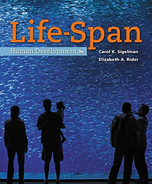Solution Found!
Differences in Concrete and Formal Operational Thinking
Chapter 2, Problem 1(choose chapter or problem)
Distinguish between concrete operational thinking and formal operational thinking in terms of what is operated upon mentally, using specific examples if you can.
Questions & Answers
QUESTION:
Distinguish between concrete operational thinking and formal operational thinking in terms of what is operated upon mentally, using specific examples if you can.
ANSWER:Step 1 of 2
Concrete and formal operational thinking are two distinct stages of cognitive development proposed by Jean Piaget. These stages represent shifts in how individuals think and reason about the world. The main distinction between concrete and formal operational thinking lies in mental operations and the types of tasks individuals can successfully perform. Let's explore each stage and provide specific examples to illustrate the differences:
1. Concrete Operational Thinking:
Concrete operational thinking is the third stage in Piaget's theory of cognitive development, typically occurring between the ages of 7 and 11. During this stage, children develop more sophisticated cognitive abilities to think logically about concrete objects and events. Key features of concrete operational thinking include:
- Conservation: Children acquire the ability to understand that certain properties of objects, such as quantity, length, or volume, remain the same even when their physical appearance changes. For example, a child at this stage understands that pouring liquid from a short, wide glass into a tall, narrow glass does not change the amount of liquid.
- Reversibility: Children can mentally reverse actions and understand that a transformation can be undone. They recognize that operations can be performed reversely to restore the original state. For instance, a child can understand that if 4 + 3 = 7, then 7 - 3 = 4.
- Classification and Seriation: Children can classify objects based on shared characteristics and organize them in a logical sequence. They can group objects based on shape, size, color, or function attributes. Additionally, they can arrange objects in a series according to a specific criterion, such as length or weight.
- Decentration: Children can consider multiple aspects of a situation and understand that different dimensions can be simultaneously considered. They no longer focus solely on one aspect of a problem but can consider multiple factors. For example, a child can understand that a longer stick may be heavier than a shorter stick, even if the longer stick appears thinner.
Concrete operational thinking is characterized by the ability to reason logically about concrete, tangible objects and events in the immediate environment. Mental operations are performed on physical objects and rely heavily on hands-on experiences and manipulation.
Watch The Answer!
Differences in Concrete and Formal Operational Thinking
Want To Learn More? To watch the entire video and ALL of the videos in the series:
This video explores Jean Piaget's theories of child development, specifically focusing on Concrete Operational and Formal Operational Thinking stages and illustrating their distinctions through the Pendulum Experiment.
